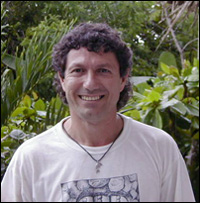
 | Jaime Awe is a Belizean archaeologist with 22 years of field experience in Maya archaeology. He has taught at universities in Canada, England, and the United States and is currently an assistant professor of anthropology at the University of New Hampshire. Awe is the director of the Western Belize Regional Cave Project, conducting intensive field research in several caves in western Belize and comparing the information gathered from this region with that recorded in other areas of the Maya lowlands. He is also currently directing excavations at Cahal Pech. |
Why did you begin the cave project?
I began the cave project for two major reasons. One having to do with conservation, the other having to do with comprehension. In regard to conservation, I was concerned that during the past 10 years there has been a major increase in cave tourism in Belize. Many of the sites are being accessed by tour groups, and many of the cultural remains are being destroyed. I hoped that my project would be able to record much of this data before it was permanently lost and also to educate the public on the fragile nature of cave sites.
In terms of comprehension, we know incredibly little of the type of activities that were conducted at the cave sites by the ancient Maya. We know, for example, that caves were regarded as sacred places and that the Maya often conducted ceremonies in them. But who conducted these ceremonies, the nature of the rituals, and the purpose they served are poorly understood. It is our hope that long-term regional study of caves can provide clues and answers to these very questions.
What are your specific research questions?
The first has to do with chronology. When were these caves first used? During what time of Maya civilization do we find that they are most intensively visited?
Another question has to do with who the people were or what members of Maya society were going to these caves. Were they common folk or elite individuals such as priests?
Another deals with the type of activities the Maya were conducting in these caves. Were they using them as places of ritual, as a place of burial, or as areas for the exploitation of certain resources?
Because we find human remains in the caves, we are interested in determining whom these individuals represent. Are they prodominently males or females? Is there any age group in particular that is being interred in these sites?
Perhaps the most important question has to do with ascertaining whether caves in the past, like today, were considered very sacred places. Where did the Maya conduct important ceremonies, and what was the focus of those ceremonies?
Finally, what is the relationship between the large surface sites that we find and the caves that we are investigating? For example, we know that there are many caves just up river from Cahal Pech where we have also been excavating. Is it possible that occupants of this site may have traveled to these caves to conduct their rituals?
How do you go about finding these cave sites?
We actually use several approaches. The first is word of mouth. Generally we go into rural communities and interview farmers and hunters. We ask them if they know of any of these sites and if they are willing to take us to them.
Another approach is by looking at the geology of the region. We know that most of the caves are formed in karst (limestone) environments. Because most of them are formed by streams, we will walk up a main river and then we will follow any branch joining the river as they often come out of a cave entrance.
We also use aerial photography. Often we can see sinkholes from the air and, if we can get a coordinate, we can go out and identify them. We also look at maps. Where we have streams on a map disappearing, it is often because they disappear within a cave.
What are the challenges of doing cave research?
Cave research is very likely one of the most difficult fields of investigation in Maya archaeology. First of all, we work in a totally dark environment. Thus lighting becomes a major challenge. We can't use generators inside the caves because of the carbon dioxide that it produces, so we have to completely rely on battery-powered or carbite-powered lamps. These are very costly, so it makes it more expensive to excavate. Some caves are also extremely damp and, because most of them are formed by rivers, it means that you also work completely wet.
Another problem is that many caves rarely have stratified deposits. All the cultural remains from different time periods are found right next to each other, making it difficult to determine different periods of activity.
Some caves are also difficult to traverse, requiring training in spelunking, such as rock climbing and repelling. Other people suffer clastophobia, and therefore they often find that working in small chambers is difficult to deal with. In caves with large deposits of bat guano, it is also possible to acquire a disease known as histoplasmosis. Finally, many of the caves are in remote areas that one has to hike over difficult terrain to reach.
Intro | Trip to Xibalba | Interview | Field Notes | Student Journals | Remote Sensing | Q&A | Map
Advertisement

Advertisement







